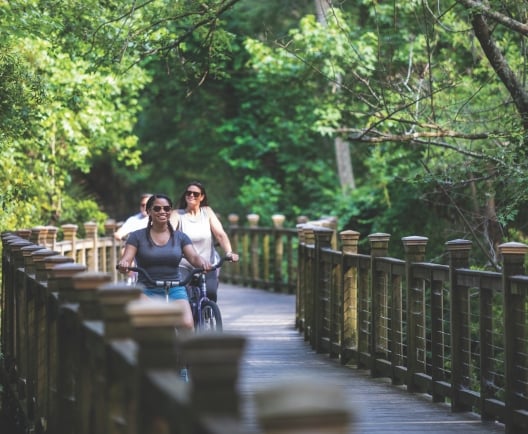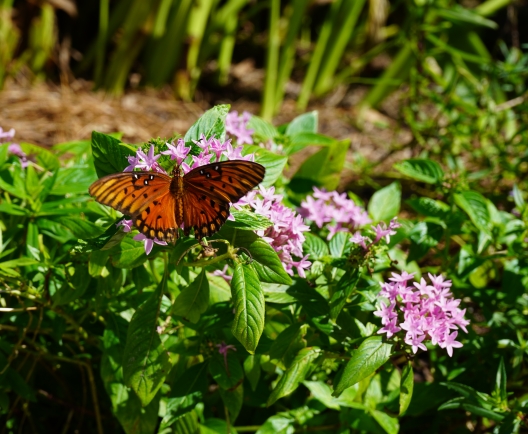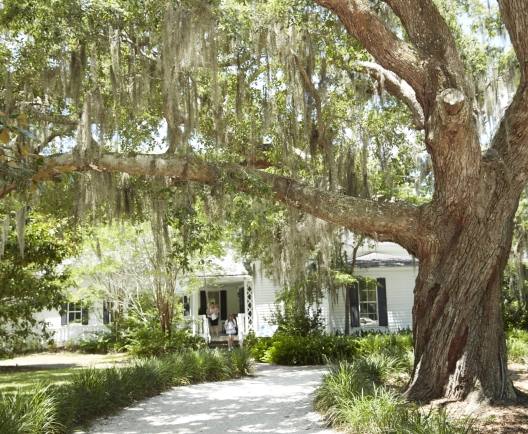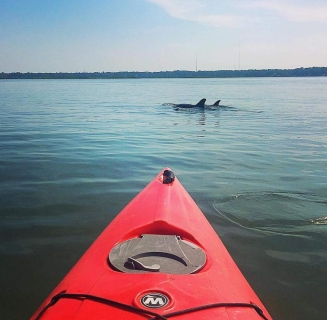
Ecotourism on Hilton Head Island
Hilton Head Island is a natural paradise, home to 12 miles of pristine white sand beaches, awe-inspiring sunsets, and famous sea turtles that nest on our shores every year. As stewards of this unique ecosystem, we know that preservation doesn’t happen by accident. That’s why we encourage all visitors to take the Hilton Head Island promise, which includes: to leave behind nothing but your footprints, to make things easier for sea turtles and their hatchlings, to protect the sand dunes and sea oats, and leaving coastal creatures undisturbed.
Want to explore Hilton Head Island sustainably? Here’s a suggested eco-friendly itinerary to get you started.
Day 1: Tour on Two Wheels
When you first arrive on Hilton Head Island, you might wonder where to begin engaging with our legendary scenic outdoor landscape. As the largest barrier island in the Southeastern United States, there are plenty of options. One of the most fun ways to get around also happens to be very eco-friendly: go on two wheels. Lucky for you, America’s Favorite Island® is renowned for its bikeability.
Recognized as a Gold Level Bicycle Friendly Community by the American League of Bicyclists, Hilton Head Island offers over 70 miles of leisure pathways, so you can cycle to beautiful beaches and every point of interest. While many visitors like to bring their own wheels, you’re never far away from an opportunity to rent a bike if you’d prefer. You’ll find nearly 30 bicycle rental shops here, offering around 15,000 bikes.
Cycling will get you out and breathing the fresh coastal air. Our extensive pathway network provides a safe and fun transportation alternative, seamlessly linking residential, commercial, and recreational areas. It’s the perfect way to combine scenic beauty, a relaxed pace, and a healthy lifestyle, all while enjoying the simple pleasure of cycling.
After a day spent cruising from the beaches to the bike paths and everywhere in between, you’re sure to have worked up an appetite. Hilton Head Island is home to over 250 restaurants, and many of them serve locally sourced and sustainable ingredients. With a wide range of global flavors on offer, you can find something local to satisfy your cravings and refuel after a day of exploration.

Day 2: Take a Tour to Meet Our Wildlife
Spend the day delving deeper into the avian wonders of Hilton Head Island by going on a bird-watching tour at the Audubon Newhall Preserve. Free guided nature tours of the Preserve are held weekly on Tuesday and Friday mornings. There aren’t many environments where you have the chance to encounter dolphins, native bird species, and sea turtles. Hilton Head Island is a bird watcher’s paradise, boasting a protected wetland habitat that attracts a stunning array of avian life, including egrets, sandpipers, wood storks, seagulls, pelicans, and majestic osprey eagles. Nearly 200 species of birds flock to Hilton Head Island, and over the past 10 years, more than 350 species of native birds have been seen here.
Many of our boat tour companies offer dedicated bird and wildlife viewing excursions. You can board a Dolphin & Nature Cruise for a chance to see Atlantic bottlenose dolphins as well as a variety of shorebirds, such as egrets, pelicans, and bald eagles. For a guided eco-tourism experience, book a tour with local experts. Some even allow you to operate a skiff boat on immersive adventures where you can observe dolphins and other wildlife thriving in their natural habitat.

Day 3: Play a Certified Audubon Cooperative Sanctuary Golf Course
For passionate golfers, there’s no better way to get out and enjoy the greenspace than by enjoying a round on a gorgeous golf course. Hilton Head Island is famous for its 23 spectacular courses and perfect golfing weather, but did you know it’s also home to Certified Audubon Cooperative Sanctuary golf courses? This certification “guides golf facilities in protecting resources and enhancing the environmental quality of their property” including improving wildlife habitats and incorporating eco-friendly practices.
Each golf course at The Sea Pines Resort is a Certified Audubon Cooperative Sanctuary golf course, along with the Arthur Hills course at Palmetto Dunes and Bear Creek Golf Club at Hilton Head Plantation. If no trip to Hilton Head Island would feel complete without hitting the links, you can rest assured that you can choose a sustainable course destination for your eco-tourism trip. The Sea Pines Resort’s three golf courses are loved by PGA TOUR pros (the annual RBC Heritage Classic takes place at Harbour Town Golf Links) and passionate non-pros alike. The Sea Pines Resort maintains several award-winning green initiatives, including a robust recycling program and building oyster reefs with discarded shells.
When you’ve finished the round, you can keep up the theme by dining on local seafood from our coastal waters. Coast Oceanfront Dining at The Sea Pines Resort is a favorite for fresh-caught meals in an elegant setting paired with breathtaking views. Golfers at Palmetto Dunes can enjoy seasonally inspired and locally sourced seafood at Alexander’s Restaurant & Wine Bar, which proudly boasts a menu of elegant takes on Lowcountry classics.

Day 4: Explore More of Our Wild Land on Foot
America’s Favorite Island® is home to some of South Carolina’s most scenic trails, which wind through areas overflowing with gorgeous plants, wild animals, and magnificent marshlands. Cross the J. Wilton Graves Bridge to Pinckney Island and stroll the 3.5-mile trail bordered by water and watched over by dolphins and alligators. Birds and foliage spill onto the trail in some places, making the scenery even more spectacular. You can also walk within the Sea Pines Forest Preserve to enjoy Hilton Head Island’s last tract of undisturbed land, where you can be awed by a 4,000-year-old Indian Shell Ring.
Want to wander by foot but at a slightly faster pace? Many visitors love to jog on our beaches, allowing them to cover more ground and see more of our 12 miles of pristine beaches. While breathing in the fresh ocean air, you can observe the flora and fauna that congregate near the water.

Day 5: Discover Our Vibrant Waterways
For decades, Hilton Head Island has been a leader in environmental sustainability, a commitment that helps preserve its beautiful landscapes, including hundreds of acres of native old-growth wetlands and vital saltwater marshes. These marshes are teeming with minerals and nutrients, supporting a rich diversity of plant and animal life, and creating a fascinating interface between the land and open water.
You have several exciting options to get close to these unique ecosystems. You can check out the salt marshes while embarking on a Salt Marsh Discovery tour or Dolphin and Nature Cruise. These experiences offer a chance to witness the beauty and ecological importance of Hilton Head Island’s waterways.
After spending the day on the water, dine on something straight from the water, with sustainably caught seafood from a local restaurant. For a casual atmosphere, Hudson’s Seafood House on the Docks is a waterfront spot offering the freshest oysters, shrimp, and crab the Lowcountry has to offer. Taste locally caught seafood while basking in beautiful views of Calibogue Sound. You can also choose one of SERG Restaurant Group’s 19 Hilton Head Island and Bluffton restaurants. SERG works with local farms growing sustainable produce and includes boat-to-table seafood options across their diverse portfolio of restaurants. Nectar Farm Kitchen, partners with Lowcountry producers to offer a menu focused on sustainable, health-conscious, and locally sourced cuisine.

Day 6: Dive into Our Sustainable History
The roots of sustainability run deep on Hilton Head Island. In fact, this is the site of America’s first eco-planned community, which was established by Charles Fraser in 1957. His plans prioritized the island through thoughtful, limited development and sustainable land-planning standards.
To learn more about the history of Hilton Head Island, visit the Coastal Discovery Museum, a Smithsonian affiliate that sits on the site of Honey Horn. This historic 70-acre property embraces Hilton Head Island’s landscape. Nature trails feature shade from ancient oaks and the area is a habitat for butterflies and dragonflies, while marsh-front boardwalks allow you to explore the tidal creek that borders the property. For a memorable garden experience, don’t miss the Carnivorous Plants Bog Garden, home to insect-eating plants that are native to South Carolina, including Venus flytraps and sundews.
The museum provides interpretive programs and exhibits about the Lowcountry's unique ecosystem and history to educate families, schools, and visitors. You can also visit the Tom Peeples Discovery Lab to get a closer look at local animals like horseshoe crabs, hermit crabs, lizards, and snakes.

Start Planning Your Eco-Friendly Getaway
Now that you know a bit more about sustainability on America’s Favorite Island®, start planning your eco-friendly trip. With the Hilton Head Vacation Planner, you can read more about green initiatives and map out every detail. We look forward to welcoming you here!
More Trending Stories

Outdoor Adventures on Hilton Head Island
Renowned as America's Favorite Island®, Hilton Head Island is a paradise for the outdoorsy types. With ideal weather year-round, adventure enthusiasts...

Wildlife to Spot on Hilton Head Island
Nature runs wild on Hilton Head Island, where lush landscapes and diverse ecosystems create a haven for wildlife at every turn. From sea turtles...

A Pickleball Guide to Hilton Head Island
Pickleball is the fastest growing sport in the United States, and here on Hilton Head Island, it's quickly becoming a popular pastime for locals and...